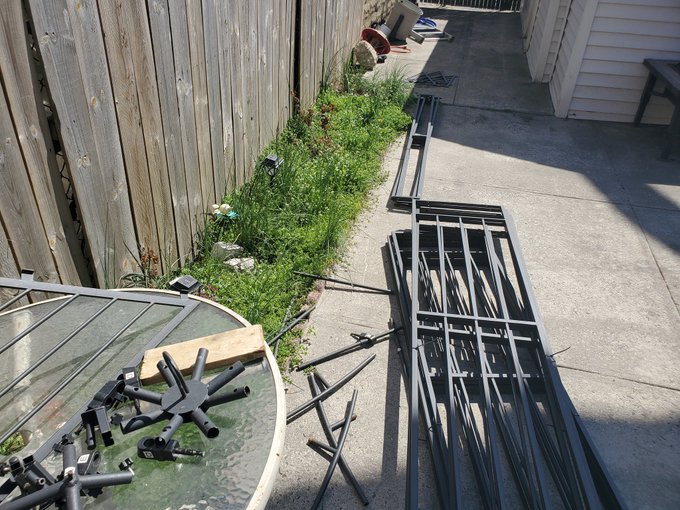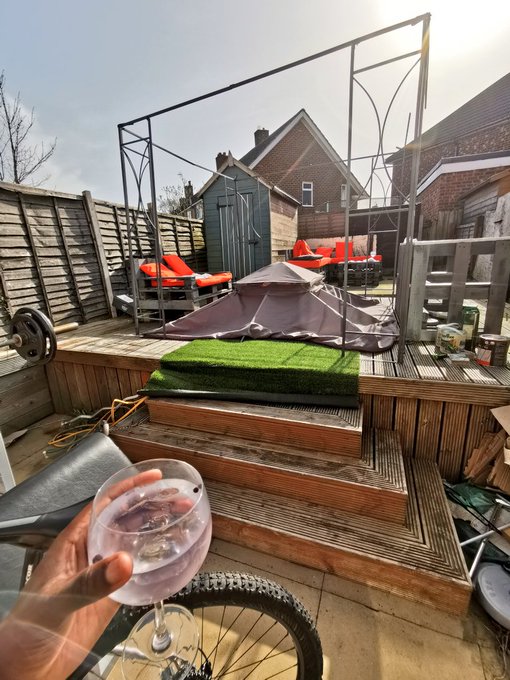Does Your Garden Winds Canopy Have Pin Holes In It
Are you wondering how to secure a gazebo from the wind?
Gazebos are fantastic structures capable of providing protection against the elements. In the winter, your gazebo can keep you dry and out of the rain or even provide a warm place for you to huddle around a fire with your friends.
In the summer months, a gazebo gives you a crucial source of shade, so you can enjoy all afternoon in your garden without worrying about overheating.
The biggest problem most people have with gazebos is figuring out how to secure them against all weather conditions. Knowing how to secure a gazebo against the wind will stop these structures from breaking or flying away when the next wind storm rolls in.
Preparing to Secure Your Gazebo
Day 1 in the life of the new gazebo and it's survived! Pizza, gin and a lovely first evening of the #Easter holidays with the Ham family. https://t.co/EWERt28lBx

The good news for gazebos owners is that there are various ways to secure a gazebo to the ground. However, the method you use will depend on the type of gazebo you have and the ground you're going to use for your gazebo set up.
If you have a gazebo with metal gazebo legs, for instance, it might be better suited for being screwed into a concrete platform. Alternatively, if you're using a gazebo on a dirt or grass surface, then you won't be able to use concrete footers in the same way. Instead, you might prefer to use rods, straps, or weights to hold your gazebo down.
Here are some of the ways you can secure your gazebo:
Using Gazebo Leg Weights
As more homeowners purchase gazebo walls for their outdoor seating areas and hot tubs, gazebo weights become increasingly common. You can find metal weights with a design that wraps around the gazebo legs and helps to keep them fastened to the ground.
Another option is to use sandbags as weights, which you can also connect to the legs of your gazebo to keep it protected against various kinds of weather and damage. Weights work with both concrete and grass, but you'll need to ensure that you have the right weights to secure each leg. Most of the time, you'll need at least 100kg in total to keep your gazebo secure.
Pegs and Ropes
If you're securing your gazebo to a grass surface, first, make sure it's level. It will help to reduce the risk of your gazebo tipping over in bad weather conditions. You can use sand and dirt to even out the area where your structure is going to sit. Once you've found the perfect area, you can use some strap and peg components to hold the gazebo to the ground.

Push gazebo stakes or pegs into the ground at each of the corners for the gazebo. Then, use a strong rope or thick cord to thread through the stakes and connect to each leg of the gazebo. You can also take the rope all the way up the corners of the gazebo to the corners of the inner roof canopy. For more security, don't be afraid to use a larger number of rope and peg combinations.
Threaded Rods
It is a solution to secure a gazebo if you plan to use it as a permanent structure. If you want to change the place of your gazebo in the future, or you might want to take it off your patio from time to time, you should consider the straps or weights instead.
You'll need about two threaded rods for each leg of your gazebo, depending on the design of the structure. You may also need to drill the rods directly into the feed of the legs, so make sure you have the right drill bit available. The rods will need to be long enough to push it deep down into the grass below. You'll need around 25 inches for each of the rods through your gazebo leg.
Anchoring Kits
Another way to secure your gazebo to the grass is with anchor kits if you don't want to use leg weights or straps. Anchor kits are similar to using the straps and pegs we mentioned above. One of the main differences is that these kits can help protect your gazebo from wind strengths that are much higher because they're more secure.
An anchor kit is ideal for protection against winds because the pegs are corkscrewed in style, which makes it harder for you to rip them from the top of the ground. You'll need to screw around four pegs into the ground for each corner or gazebo leg. Feed straps through the peg loops and up into the gazebo walls until you reach the corners of the roof.
Secure to Concrete
If you want to secure your gazebo to concrete, one of the best ways to do that is with the right screws. You can get gazebos that come with feet that have screw sections in them, particularly for this reason. If you're beginning to install a concrete area at home, you could also embed the legs of the gazebos into the concrete and wait for the concrete to set.
Once again, using this "embedding" option will be a better choice if you want your gazebo to be a permanent fixture in your backyard. If you're just planning on using the canopy, for now, look for tips that you can use to screw the legs into the patio. This way, you can remove the screws and refill the hole left behind later.
Ratchet Straps
Finally, Polypropylene straps or ratchet straps are an excellent solution for securing gazebos in harsh weather conditions. If you're worried about damage from high winds, this could be the product for you. The straps have an extremely high breaking point, and you can use them with various types of pegs and other structures.
To get the best results from your ratchet straps, you may need a heavy fixed structure underneath your gazebos with steel rings embedded into a concrete surface. This way, you can attach the metal hooks from the straps to the concrete underneath. Although this is a secure way to protect your gazebo, you might find that it detracts from the look of your home.
How Much Wind Can a Gazebo Withstand?
A gazebo can be a wonderful thing for a homeowner that wants to make the most of the garden all year round. Unfortunately, gazebos aren't always designed to withstand a high amount of wind. If you're planning on buying a gazebo, you must check the resilience of the material it's made out of, so you know whether you're going to need to use one of the securing methods above.

Most of the time, well-made gazebos can withstand light winds. However, there's a risk that the wind will tip your gazebos over if it's not secured at all. A medium wind is more likely to knock your gazebo over or cause damage to the internal materials in your gazebos. Higher winds could break the gazebo and cause damage in a number of ways, including to the legs and top of your device.
The strength of your gazebo materials and the weight of the legs will help you to determine how well it can hold up to wind. You can also search for a brand name or product name online to see what kind of conditions it can withstand.
Install Your Gazebo
Figuring out how to secure a gazebo from the wind and bad weather conditions is crucial if you want to get the most out of your gazebos. Most of the time, at least one form of securing mechanism mentioned above must be used to keep your gazebo in place.
Weigh It Down
Even if you just use leg weights to secure a gazebo, it can save you from a lot of damage and trouble in the long term. Remember, whether you're using a staff, pegs, or something else to protect your gazebo, follow the instructions provided for the option you choose.
Position Your Gazebo Correctly
Additionally, keep in mind that every type of gazebo protection will work best if you position your gazebo in the right place, to begin with. Orienting your gazebo, so it's less likely to be affected by the wind is often a good idea. Consider placing it close to a fence or trees, for instance.
Fix the Vinyl Sides
It can also help to keep the vinyl sides or cloth of your gazebo up or tied back against the leg during windy days. The tie-back feature on some gazebos isn't just there to make it look good on your patio. When you tie the curtains or walls back, you also create a hole for the wind to move through. It reduces some of the pressure on the gazebo that could cause it to slip off its leg weights or tip.
Enjoy the Shade
When you properly secure your gazebo, there's no need to worry about harsh weather conditions. What's more, You'll have peace of mind that your investment won't blow away with the strong wind.
How do you secure your gazebo? Do you have any tips for us? Let us know below.
Additional Resources
- How Long Does Artificial Grass Last
- How to Install Artificial Grass
- How to Care for Artificial Grass
Does Your Garden Winds Canopy Have Pin Holes In It
Source: https://www.housejunkie.co.uk/how-to-secure-a-gazebo-from-the-wind/
Posted by: hatchsubte1954.blogspot.com

0 Response to "Does Your Garden Winds Canopy Have Pin Holes In It"
Post a Comment